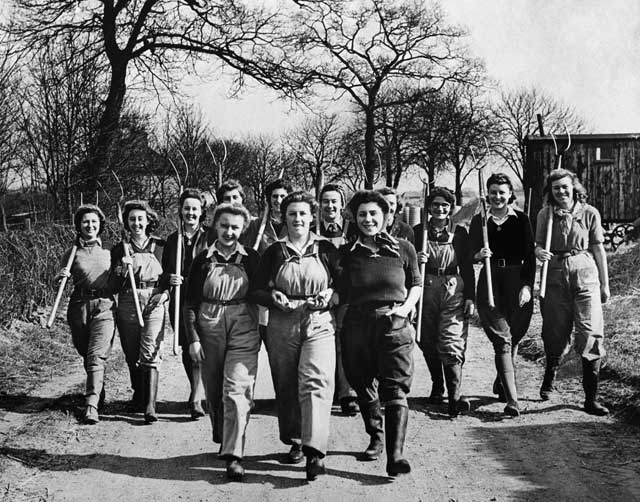The Taste of War: World War Two and the Battle for Food, By Lizzie Collingham

Food is the first thing, morals follow on," wrote Brecht, as well he might in the Germany of his day. In this powerful and important book, Lizzie Collingham shows that the Second World War was about food. Like all the best ideas, Collingham's means that a lot of events fall satisfyingly into place. Events in the First World War caused the Second: both Britain and Germany endured food shortages, but in Germany they were crushing, and the continuing blockade in 1918-19 ensured a revolution from the left. The young Adolf Hitler never forgot, and he set out to prevent a recurrence. His plan for lebensraum was his attempt to give Germany its own version of the American breadbasket. If there was more farmland, Germany would be immune to blockade, and able to challenge Anglophone power.
No sooner was the dream realised than it collapsed. German farmers didn't want to go to "the east" and under-performed when they arrived. Germany's ally Japan also thought the solution to its food needs was expansion. As the Depression crushed Japan's farmers, the army annexed Manchuria, where Japanese pioneers were to farm. As in the Nazis' General Government, the plan failed.
So both the Axis powers embarked on a war to secure enough food to be able to tell the world where to go, and both entirely failed to create local food supplies in conquered lands. Still, the Nazis did not accidentally underfeed the untermenschen they conquered; starving them was a policy which Hitler compared with the destruction of the "Red Indians".
Collingham illuminates the war in Britain, too. One of the beauties of this book is its savage unpicking of cherished myths about wartime Britain. The command economy was chaotic. Ploughing up land for grain led to massive fertilisation, for which nitrogen had to be imported from Canada. Potatoes were overproduced and had to be fed to pigs. The Women's Land Army endured perpetual hunger when farmers kept back protein for their own families and left the girls with beetroot sandwiches.
When bounteous food supplies did arrive from America, the Ministry of Food held them back, terrified that imports would fall further, so that much of the food was wasted. Spam and dried egg and other US imports came in with Lend-Lease, shattering the myth of healthy independence. The horrible powders and loathsome pastes included dried banana powder, and such condensed foods were far from the healthy diet trumpeted by "Dr Carrot" and co.
The British government knew that the working classes had an awful diet, scraping by on white bread, margarine, jam, pieces of bacon, and tea. But not even the war really shifted the longing for such foods. As soon as people could, they began eating them again, in larger amounts. The whole food control system was, Collingham hints, the blueprint for the welfare state that was to succeed it, but she also documents signs of resistance and rebellion, like the factory workers who wanted fish, chips and gravy.
A particular strength is Collingham's stress on the Empire. So far was Britain from standing alone that Australia restructured its own sheep industry to produce dehydrated mutton for her, while New Zealand supplied Britain with meat which it could ill afford, and hence had to introduce rationing. The people who were truly alone were the Bengalis, who endured an appalling famine in 1943-44 in which 1.5 million people died.
The British army was fed, but not fed well, while the US Army was notorious in two hemispheres for its magnificent food. The Coca-Cola Company conquered the world. Everybody was exposed to the enviable culture of plenty. Some of the exposure was unpleasant. In Townsville, Australia, all fresh food disappeared into the US base, on Macarthur's orders.
The most tragic story is that of the Pacific islands, where the occupying Americans fed the inhabitants generously, but also destroyed their gardens to make airstrips. Then they left. The stunned islanders were no longer able to grow food for themselves.
The war was won through hunger, though only in the Far East. In Japan, the Emperor feared an uprising by the starving, and surrendered to the logic of the atomic bombs. But in Europe, the starving Russians fought on and on. The Germans overrated the power of hunger to subdue them because they thought hunger had subdued them in 1918.
The war for food made hunger grow. In 1945, Germans were on 1,000 calories a day. By the late 1940s, Russians were still living on tea and potatoes. The British kept rationing, and extended it to bread and potatoes. As in the war years, the Americans were far better fed than everybody else, but livestock had begun eating so much grain that there was little left for the hungry world which cast longing eyes towards it, hoping for crumbs.
Once we were the hungry; now we can eat as much as we want, as they could then. Like them, we pay a high price for it, in pesticides and in health, and in the starving world which longed for the husks we give to swine. Perhaps all wars are caused by such savage envy. As the number of hungry people rises worldwide, we are probably not far from the next war for food.
Diane Purkiss's 'The English Civil War: a people's history' is published by HarperPerennial
Subscribe to Independent Premium to bookmark this article
Want to bookmark your favourite articles and stories to read or reference later? Start your Independent Premium subscription today.

Join our commenting forum
Join thought-provoking conversations, follow other Independent readers and see their replies